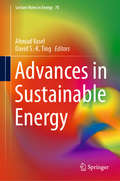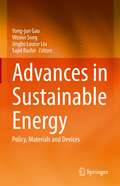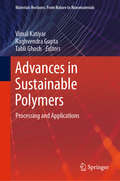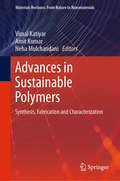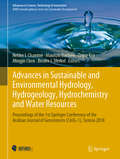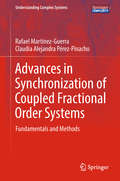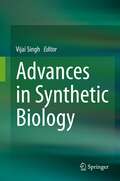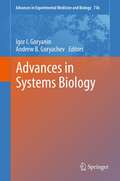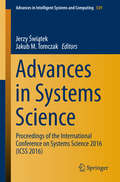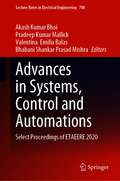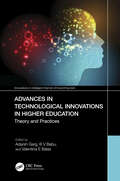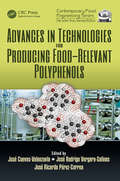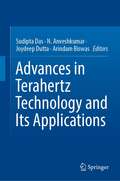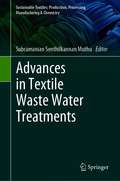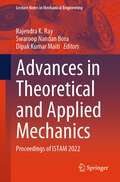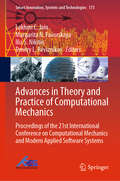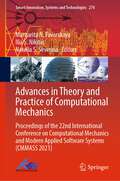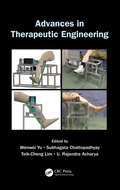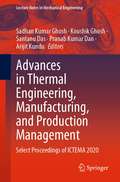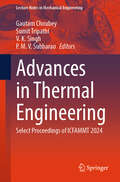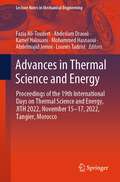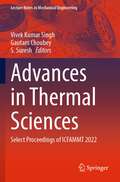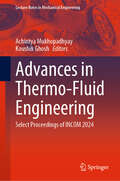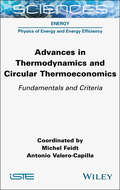- Table View
- List View
Advances in Sustainable Energy (Lecture Notes in Energy #70)
by Ahmad Vasel David S-K. TingThis book reveals key challenges to ensuring the secure and sustainable production and use of energy resources, and provides corresponding solutions. It discusses the latest advances in renewable energy generation, and includes studies on climate change and social sustainability. In turn, the book goes beyond theory and describes practical challenges and solutions associated with energy and sustainability. In particular, it addresses: · renewable energy conversion technologies; · transmission, storage and consumption; · green buildings and the green economy; and · waste and recycling. The book presents the current state of knowledge on renewable energy and sustainability, supported by detailed examples and case studies, making it not only a cutting-edge source of information for experts and researchers in the field, but also an educational tool for related undergraduate and graduate courses.
Advances in Sustainable Energy: Policy, Materials and Devices
by Sajid Bashir Jingbo Louise Liu Yong-Jun Gao Weixin SongThis books provides a comprehensive platform to the scientific, education and research communities working on various fields related to sustainable energy. It covers the exploration, generation and application of this area to meet societal needs as well as addressing global issues related to the environment. The content of this book presents research related to energy and how to tackle climate change as a comprehensive framework based on the success of the Millennium Development Goals (MDGs). The authors use the scientific method to analyze and deliver viable technical solutions, demonstrating how chemistry and engineering can be combined to solve technically challenging problems. While maintaining high scientific rigor, a quantitative approach is offered in select chapters to the study of energy related to our societies increasing need for electrical and chemical energy feedstocks.
Advances in Sustainable Polymers: Processing and Applications (Materials Horizons: From Nature to Nanomaterials)
by Vimal Katiyar Raghvendra Gupta Tabli GhoshThis book provides a systematic overview of the processing and applications of sustainable polymers. The volume covers recent advances in biomedical, food packaging, fuel cell, membrane, and other emerging applications. The book begins by addressing different sections of biomedical application including use of carbohydrate-based therapeutics, nanohybrids, nanohydrogels, bioresorbable polymers and their composites, polymer-grafted nanobiomaterials for biomedical devices and implants, nanofibres, and others. The second part of this book discusses various processing and packaging materials for food packaging applications. The last section discusses other emerging applications, including using microbial fuel cells for waste water treatment, microfluidic fuel cells for low power applications, among others. This volume will be relevant to researchers working to improve the properties of bio-based materials for their advanced application and wide commercialization.
Advances in Sustainable Polymers: Synthesis, Fabrication and Characterization (Materials Horizons: From Nature to Nanomaterials)
by Amit Kumar Vimal Katiyar Neha MulchandaniThis book discusses synthesis and characterization of sustainable polymers. The book covers opportunities and challenges of using sustainable polymers to replace existing petroleum based feedstock. This volume provides insights into the chemistry of polymerization, and discusses tailoring the properties of the polymers at the source in order fit requirements of specific applications. The book also covers processing of these polymers and their critical assessment. The book will be of use to chemists and engineers in the industry and academia working on sustainable polymers and their commercialization to replace dependence on petroleum-based polymers.
Advances in Sustainable and Environmental Hydrology, Hydrogeology, Hydrochemistry and Water Resources: Proceedings of the 1st Springer Conference of the Arabian Journal of Geosciences (CAJG-1), Tunisia 2018 (Advances in Science, Technology & Innovation)
by Mingjie Chen Helder I. Chaminé Maurizio Barbieri Ozgur Kisi Broder J. MerkelThis book comprises the selected papers from the 1st Springer Conference of the Arabian Journal of Geosciences (CAJG-1), Tunisia 2018. The volume is of interest to all researchers and practitioners in the fields of Hydrology, Hydrogeology, Hydrochemistry, Water Resources and Hydrologic Engineering. Water is a dynamic, finite, and vulnerable but resilient natural resource to be protected in an environmentally sustainable manner. Water systems in different frameworks requires a comprehensive understanding of climatology, geology, hydrogeology, hydrochemistry, hydrodynamics, and surface hydrology. In addition, it is highlighted the role of the variability and climate change in water systems. Furthermore, water has a vital significance to the entire socio-economic sector. This volume offers an overview of the state-of-the-art related to water science and technology in model regions in Europe, Africa, Middle East, Asia and America, but mainly focuses on the Mediterranean environment and surrounding regions. It gives new insights on characterisation, evaluation, quality, management, protection, modelling on environmental hydrology, groundwater, hydrochemistry, sustainable water resources studies and hydrologic engineering approaches by international researchers. Main topics include: 1. Hydrology, Climatology and Water-Related Ecosystems2. Hydrochemistry and Isotopic Hydrology3. Groundwater Assessment and Management: mapping, exploration, abstraction and modelling4. Water Resources Sustainability and Climate Change5. Hydrologic Engineering and Urban Groundwater
Advances in Synchronization of Coupled Fractional Order Systems: Fundamentals and Methods (Understanding Complex Systems)
by Rafael Martínez-Guerra Claudia Alejandra Pérez-PinachoAfter a short introduction to the fundamentals, this book provides a detailed account of major advances in applying fractional calculus to dynamical systems. Fractional order dynamical systems currently continue to gain further importance in many areas of science and engineering. As with many other approaches to mathematical modeling, the first issue to be addressed is the need to couple a definition of the fractional differentiation or integration operator with the types of dynamical systems that are analyzed. As such, for the fundamentals the focus is on basic aspects of fractional calculus, in particular stability analysis, which is required to tackle synchronization in coupled fractional order systems, to understand the essence of estimators for related integer order systems, and to keep track of the interplay between synchronization and parameter observation. This serves as the common basis for the more advanced topics and applications presented in the subsequent chapters, which include an introduction to the 'Immersion and Invariance' (I&I) methodology, the masterslave synchronization scheme for partially known nonlinear fractional order systems, Fractional Algebraic Observability (FAO) and Fractional Generalized quasi-Synchronization (FGqS) to name but a few. This book is intended not only for applied mathematicians and theoretical physicists, but also for anyone in applied science dealing with complex nonlinear systems.
Advances in Synthetic Biology
by Vijai SinghThis book addresses the design of emerging conceptual tools, technologies and systems including novel synthetic parts, devices, circuits, oscillators, biological gates, and small regulatory RNAs (riboregulators and riboswitches), which serve as versatile control elements for regulating gene expression. Synthetic biology, a rapidly growing field that involves the application of engineering principles in biology, is now being used to develop novel systems for a wide range of applications including diagnostics, cell reprogramming, therapeutics, enzymes, vaccines, biomaterials, biofuels, fine chemicals and many more. The book subsequently summarizes recent developments in technologies for assembling synthetic genomes, minimal genomes, synthetic biology toolboxes, CRISPR-Cas systems, cell-free protein synthesis systems and microfluidics. Accordingly, it offers a valuable resource not only for beginners in synthetic biology, but also for researchers, students, scientists, clinicians, stakeholders and policymakers interested in the potential held by synthetic biology.
Advances in Systems Biology (Advances in Experimental Medicine and Biology #736)
by Igor I. Goryanin Andrew B. GoryachevThe International Society for Systems Biology (ISSB) is a society aimed at advancing world-wide systems biology research by providing a forum for scientific discussions and various academic services. The ISSB helps coordinate researchers to form alliances for meeting the unique needs of multidisciplinary and international systems biology research. The annual International Conference on Systems Biology (ICSB) serves as the main meeting for the society and is one of the largest academic and commercial gatherings under the broad heading of 'Systems Biology'.
Advances in Systems Science: Proceedings of the International Conference on Systems Science 2016 (ICSS 2016) (Advances in Intelligent Systems and Computing #539)
by Jerzy Świątek Jakub M. TomczakThis book gathers the carefully reviewed proceedings of the 19th International Conference on Systems Science, presenting recent research findings in the areas of Artificial Intelligence, Machine Learning, Communication/Networking and Information Technology, Control Theory, Decision Support, Image Processing and Computer Vision, Optimization Techniques, Pattern Recognition, Robotics, Service Science, Web-based Services, Uncertain Systems and Transportation Systems. The International Conference on Systems Science was held in Wroclaw, Poland from September 7 to 9, 2016, and addressed a range of topics, including systems theory, control theory, machine learning, artificial intelligence, signal processing, communication and information technologies, transportation systems, multi-robotic systems and uncertain systems, as well as their applications. The aim of the conference is to provide a platform for communication between young and established researchers and practitioners, fostering future joint research in systems science.
Advances in Systems, Control and Automations: Select Proceedings of ETAEERE 2020 (Lecture Notes in Electrical Engineering #708)
by Bhabani Shankar Prasad Mishra Valentina Emilia Balas Akash Kumar Bhoi Pradeep Kumar MallickThis book comprises select proceedings of the international conference ETAEERE 2020. This volume covers latest research in advanced approaches in automation, control based devices, and adaptive learning mechanisms. The contents discuss the complex operations and behaviors of different systems or machines in different environments. Some of the areas covered include control of linear and nonlinear systems, intelligent systems, stochastic control, knowledge-based systems applications, fault diagnosis and tolerant control, and real-time control applications. The contents of this volume can be useful for researchers as well as professionals working in control and automation.
Advances in TNF Family Research: Proceedings of the 12th International TNF Conference, 2009 (Advances in Experimental Medicine and Biology #691)
by Andrew Kovalenko David Wallach Marc FeldmannThe biennial TNF-family conferences have been held over the past 20 years, from the time that TNF was cloned. These meetings have followed the enormous progress in this field. Much is now known about the members of the TNF ligand and receptor families, their signaling proteins, mechanisms of action and cellular functions. This volume is the proceedings of the 12th TNF International Conference, held in April 2009. This conference focuses on the physiological, pathophysiological, and medical significance of these important regulators. Sessions at the meeting specifically address their involvement in immunity, development, apoptosis, autoimmunity, cancer, and infection, the normal function and pathology of the neuronal system, as well as major unresolved questions about their mechanisms of action.
Advances in Technological Innovations in Higher Education: Theory and Practices (Innovations in Intelligent Internet of Everything (IoE))
by Adarsh Garg Valentina E Balas B V BabuThe evolution of technology in education can no longer be comprehended simply by looking at the use of computers and networks. Technology is not just a supplementary tool to the conventional method of education. Education has to undergo a complete transformation with technological innovations for the sustainability of quality education as a system and not in silos. Sustainability in education also necessitates a more workable strategy to realize socially viable educational policies and practices which can focus more on personalized learning. Due to various factors like emerging technologies; changing needs of the learners; policy reforms for enhancing employability; and emphasis on uninterrupted education as in the case of the pandemic scenario of COVID-19, there is a need to steer a major transition in the education system. The education system has to be real and proficient for it to be instrumental to nurture an informed and knowledgeable society. This book on technological innovations in higher education is organized, largely, based on the diversity of higher education ecosystems that are supported by technological innovations. Various author viewpoints give insights into the full potential of technology as well as its risks in interrelated areas of higher education to work towards sustainability of value-based quality education across the globe.
Advances in Technologies for Producing Food-relevant Polyphenols (Contemporary Food Engineering)
by José Cuevas-Valenzuela, José Rodrigo Vergara-Salinas and José Ricardo Pérez-CorreaThe growing concern for human wellbeing has generated an increase in the demand for polyphenols, secondary plant metabolites that exhibit different bioactive properties. This increasing demand is mainly due to the current applications in the food industry where polyphenols are considered essential for human health and nutrition. Advances in Technologies for Producing Food-relevant Polyphenols provides researchers, scientists, engineers, and professionals involved in the food industry with the latest methodologies and equipment useful to extract, isolate, purify, and analyze polyphenols from different available sources, such as herbs, flora, vegetables, fruits, and agro-industrial wastes. Technologies currently used to add polyphenols to diverse food matrices are also included. This book serves a reference to design and scale-up processes to obtain polyphenols from different plant sources and to produce polyphenol-rich foods with bioactive properties (e.g. antioxidant, antibacterial, antiviral, anticancer properties) of interest for human health and wellbeing.
Advances in Terahertz Technology and Its Applications
by Joydeep Dutta Arindam Biswas Sudipta Das N. AnveshkumarThis book highlights the growing applications of THz technology and various modules used for their successful realization. The enormous advantages of THz devices like higher resolution, spatial directivity, high-speed communication, greater bandwidth, non-ionizing signal nature and compactness make them useful in various applications like communication, sensing, security, safety, spectroscopy, manufacturing, bio-medical, agriculture, imaging, etc. Since the THz radiation covers frequencies from 0.1THz to around 10THz and highly attenuated by atmospheric gases, they are used in short-distance applications only. The book focuses on recent advances and different research issues in terahertz technology and presents theoretical, methodological, well-established and validated empirical works dealing with the different topics.
Advances in Textile Waste Water Treatments (Sustainable Textiles: Production, Processing, Manufacturing & Chemistry)
by Subramanian Senthilkannan MuthuThe textile waste water is well known to contain many detrimental impacts in terms of its pollutants and the issues pertaining to its discharged without being untreated, or even discharged without meeting all stipulated parameters. There is an ample amount of advancements in treating textile waste water in a sustainable way and this book comprehends the same with eight insightful chapters. The aim of this book is to deal with the advances in sustainable waste water treatments with topics Conjugated Polymer Coated Novel Bio-adsorbents for Wastewater Treatment , Advanced Oxidation Processes (AOP) – Effective innovative treatment methods to degrade textile dye effluent, etc.
Advances in Theoretical and Applied Mechanics: Proceedings of ISTAM 2022 (Lecture Notes in Mechanical Engineering)
by Dipak Kumar Maiti Rajendra K. Ray Swaroop Nandan BoraThis book presents select proceedings of the 67th Congress of the Indian Society of Theoretical and Applied Mechanics (ISTAM-2022). The content includes chapters on topics such as fluid mechanics, aerospace dynamics, atmospheric sciences and oceanography, geophysical environmental fluid dynamics, biomechanics, computational fluid dynamics, experimental methods in fluid dynamics, mathematical modelling, statistical mechanics, computational solid mechanics, experimental method in solid mechanics, mechanics of composites, and robotics and control. The book will be a valuable reference for researchers and professionals interested in applied and computational mechanics and allied fields.
Advances in Theory and Practice of Computational Mechanics: Proceedings of the 21st International Conference on Computational Mechanics and Modern Applied Software Systems (Smart Innovation, Systems and Technologies #173)
by Lakhmi C. Jain Margarita N. Favorskaya Ilia S. Nikitin Dmitry L. ReviznikovThis book discusses physical and mathematical models, numerical methods, computational algorithms and software complexes, which allow high-precision mathematical modeling in fluid, gas, and plasma mechanics; general mechanics; deformable solid mechanics; and strength, destruction and safety of structures. These proceedings focus on smart technologies and software systems that provide effective solutions to real-world problems in applied mechanics at various multi-scale levels. Highlighting the training of specialists for the aviation and space industry, it is a valuable resource for experts in the field of applied mathematics and mechanics, mathematical modeling and information technologies, as well as developers of smart applied software systems.
Advances in Theory and Practice of Computational Mechanics: Proceedings of the 22nd International Conference on Computational Mechanics and Modern Applied Software Systems (CMMASS 2021) (Smart Innovation, Systems and Technologies #274)
by Margarita N. Favorskaya Ilia S. Nikitin Natalia S. SeverinaThis book is a collection of peer-reviewed best selected research papers presented at 22nd International Conference on Computational Mechanics and Modern Applied Software Systems (CMMASS 2021), held at the Alushta Health and Educational Center, The Republic of Crimea, during 4–13 September 2021. The proceedings is dedicated to solving the real-world problems of applied mechanics using smart computational technology. Physical and mathematical models, numerical methods, computational algorithms and software complexes are discussed, which allow to carry out high-precision mathematical modelling in fluid, gas and plasma mechanics, in general mechanics, deformable solid mechanics, in strength, destruction and safety of structures, etc. Smart technologies and software systems that provide effective solutions to the problems at various multi scale-levels are considered. Special attention is paid to the training of highly qualified specialists for the aviation and space industry.
Advances in Therapeutic Engineering
by U. Rajendra Acharya Teik-Cheng Lim Wenwei Yu Subhagata ChattopadhyayTherapeutic Engineering (TE) is a cutting-edge domain in today's era of medical technology research. Through engineering algorithms that provide technological solutions, it aims to elevate the quality of life of disabled individuals. Advances in Therapeutic Engineering describes various therapeutic processes and mechanisms currently applied to the
Advances in Thermal Engineering, Manufacturing, and Production Management: Select Proceedings of ICTEMA 2020 (Lecture Notes in Mechanical Engineering)
by Santanu Das Sadhan Kumar Ghosh Koushik Ghosh Pranab Kumar Dan Arijit KunduThis book presents the selected peer-reviewed proceedings of the International Conference on Thermal Engineering and Management Advances (ICTEMA 2020). The contents discuss latest research in the areas of thermal engineering, manufacturing engineering, and production management. Some of the topics covered include multiphase fluid flow, turbulent flows, reactive flows, atmospheric flows, combustion and propulsion, computational methods for thermo-fluid arena, micro and nanofluidics, renewable energy and environment sustainability, non-conventional energy resources, energy principles and management, machine dynamics and manufacturing, casting and forming, green manufacturing, production planning and management, quality control and management, and traditional and non-traditional manufacturing. The contents of this book will be useful for students, researchers as well as professionals working in the area of mechanical engineering and allied fields.
Advances in Thermal Engineering: Select Proceedings of ICFAMMT 2024 (Lecture Notes in Mechanical Engineering)
by V. K. Singh P. M. V. Subbarao Gautam Choubey Sumit TripathiThe 2nd International Conference on Futuristic Advancements in Materials, Manufacturing and Thermal Sciences (ICFAMMT-2024) was jointly organized by the Department of Mechanical and Aerospace Engineering, Institute of Infrastructure, Technology, Research and Management (IITRAM), Ahmedabad, India, and the Space Society of Mechanical Engineers (SSME), Space Applications Centre, ISRO, Ahmedabad. This conference aims to provide splendid opportunities for academicians, researchers, industrial persons, and young scientists to address new challenges and discuss futuristic advancements in materials, manufacturing, and thermal sciences. This book includes select peer-reviewed proceedings of the 2nd International Conference on Futuristic Advancements in Materials, Manufacturing and Thermal Sciences (ICFAMMT 2024). The contents of this book provide an overview of the latest research in the area of thermal and fluid sciences such as computational and numerical methods in fluid flow and heat transfer, advanced energy systems, battery thermal management system, technologies for space, and aerospace applications, supersonic combustion, two-phase/multiphase flows, measurement and instrumentation for fluid flow and transport properties, micro/nano-scale fluid flow and heat transfer. The book is useful for researchers and professionals working in the field of thermal and fluid sciences.
Advances in Thermal Science and Energy: Proceedings of the 19th International Days on Thermal Science and Energy, JITH 2022, November 15–17, 2022, Tangier, Morocco (Lecture Notes in Mechanical Engineering)
by Fazia Ali-Toudert Abdeslam Draoui Kamel Halouani Mohammed Hasnaoui Abdelmajid Jemni Lounès TadristThis book covers advanced theories and methods in the field of heat and mass transfer, which are expected to improve thermal systems performance and energy efficiency. It reports on novel findings relating to a wide range of topics in industry, building, transportation and agriculture. Offering a good balance of fundamental and applied research, this book provides scientists, engineers and other professionals with a timely snapshot on advances in thermal science, renewable energies and sustainable energy technologies. It also offers a source of inspiration for future research and collaborations.
Advances in Thermal Sciences: Select Proceedings of ICFAMMT 2022 (Lecture Notes in Mechanical Engineering)
by S. Suresh Vivek Kumar Singh Gautam ChoubeyThis book presents select peer-reviewed proceedings of the International Conference on Futuristic Advancements in Materials, Manufacturing and Thermal Sciences (ICFAMMT 2022). The book provides an overview of the latest research in the area of thermal sciences such as computational and numerical methods in fluid flow and heat transfer, advanced energy systems, optimization of thermal systems, technologies for space, and aerospace applications, supersonic combustion, two-phase / multiphase flows. The book will be useful for researchers and professionals working in the field of thermal sciences
Advances in Thermo-Fluid Engineering: Select Proceedings of INCOM 2024 (Lecture Notes in Mechanical Engineering)
by Achintya Mukhopadhyay Koushik GhoshThis book presents selected extended papers from the International Conference on Mechanical Engineering (INCOM 2024), describing recent advances in thermo-fluids engineering research. Various topics covered in this book are design and analysis of thermal systems, dynamics and control of thermal systems and processes, fluid mechanics, fluid–structure interaction, heat transfer, internal combustion engines and gas turbines, multiphase flow, and heat transfer. The book is a valuable reference for researchers and professionals working in the fields of mechanical, aerospace, chemical, and power engineering and also for a number of interdisciplinary areas like materials processing, electronic, and energy storage systems where thermal management is a key design issue.
Advances in Thermodynamics and Circular Thermoeconomics: Fundamentals and Criteria
by Michel Feidt Antonio Valero-CapillaThis book on energy physics and energy efficiency discusses two essential components of energy physics: the fundamentals and the criteria. It covers the historical basis of Carnot models, the thermostatic cycles of double-function heat pumps and the optimization of thermomechanical engines, and discusses the results of various investigations, bringing together a number of previous works. The latter half of this book introduces the concept of "Circular Thermoeconomics" and assesses the physical costs of recycling waste in increasingly complex industrial processes. It then goes on to present "Relative Free Energy", allowing us to create a new mathematical theory of thermodynamic costs in order to diagnose malfunctions in thermal systems. The book shows the progression of knowledge on the existence of successive energy, power and efficiency, and pairs this with the economic aspects, which are already becoming linked to growing environmental concerns.
